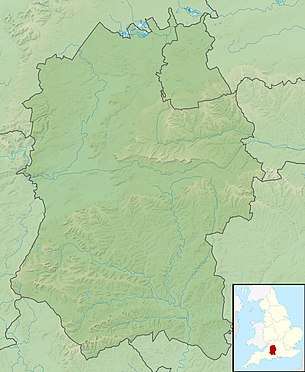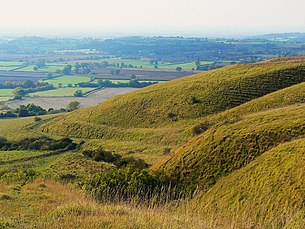Battle of Roundway Down
The Battle of Roundway Down was fought on 13 July 1643 near Devizes, Wiltshire, during the First English Civil War. A Royalist cavalry force under Lord Wilmot won a crushing victory over the Parliamentarians under Sir William Waller.
| Battle of Roundway Down | |||||||
|---|---|---|---|---|---|---|---|
| Part of First English Civil War | |||||||
.jpg) Roundway Down | |||||||
| |||||||
| Belligerents | |||||||
|
|
| ||||||
| Commanders and leaders | |||||||
|
Lord Wilmot Sir John Byron Earl of Crawford Lord Hopton |
Sir William Waller Sir Arthur Haselrig | ||||||
| Strength | |||||||
| 1,800 horse[1] |
2,500 horse[1] c 2,500 foot 8 guns | ||||||
| Casualties and losses | |||||||
| Unknown |
600 killed[1] 1,200 captured | ||||||

Background
On 5 July, Lord Hopton's Royalist army fought Sir William Waller's Parliamentarian army to a draw at the Battle of Lansdowne. In the battle, Hopton suffered many casualties and desertions. Sir Bevil Grenville, the popular commander of Hopton's Cornish troops, was killed in the battle. Hopton himself was temporarily blinded by an exploding ammunition cart. The explosion also left the Royalist army short of gunpowder forcing them to withdraw towards Oxford to get reinforcements and new supplies. After traveling east from Marshfield, the Royalist army rested at Chippenham.[2][3][4]
Waller's army remained intact after the battle and quickly replaced lost soldiers from the Parliamentarian garrison of Bristol. Waller then set out from Bath to pursue and confront Hopton's army. On 9 July, when Waller approached Chippenham, Hopton marched his troops south to the small town of Devizes to seek refuge. Waller and his force of 5,000 Parliamentarians followed south and occupied Roundway Down, high ground approximately 2 kilometers north of Devizes. Short of materials and outnumbered by the Parliamentarians, the Royalist commanders held a council of war. At the council, it was agreed that Prince Maurice would break out with the Royalist cavalry of 300 riders and race to Oxford for reinforcements while Hopton and the remaining army of 3,000 Cornish foot would continue to shelter at Devizes.[1][3][4]
Maurice and the Royalist cavalry escaped at midnight on 10 July and traveled to Oxford overnight. Maurice alerted the Royalist command of the situation at Devizes. Lord Wilmot, Lieutenant General of Horse for King Charles immediately assembled a relief force of 1,500 horse and set out for Devizes along with Maurice and his 300 riders.[1][3]
The siege of Devizes
Meanwhile on the morning of 11 July in Devizes, Waller brought his army down from Roundway Down and deployed them on the eastside of town. To support an attack, Waller set up an artillery battery within range of the town on Coatefield Hill. Fearing an attack and stalling for time, Hopton sought and received a temporary truce for treaty negotiations. Overnight as the Parliamentarians waited for Hopton’s response, their cavalry intercepted and captured a Royalist convoy of gunpowder and ammunition that had previously been dispatched to resupply Hopton after the Battle at Lansdowne. Many of the Royalist horse escaped, however, 200 were taken captive along with the wagons.[1][3]
On the morning of 12 July, Waller ended the treaty negotiations and began his assault of Devizes. The city was bombarded by artillery fire and the Parliamentarian infantry rushed the outworks and fortifications battling the Royalists in hand-to-hand combat. At the end of the day, the Royalists remained in control of Devizes.[1][3]
On the morning of 13 July, Waller was informed of the approach of Wilmot and the Royalist relief force. Desiring to confront the relief force head-on, Waller abandoned the siege of Devizes and marched his force back north to Roundway Down. On high ground, Waller deployed his infantry and artillery in the centre of his formation with cavalry on each flank. Waller commanded the cavalry on the left flank while Sir Arthur Haselrig commanded the cavalry on the right.[1][5]
The battle of Roundway Down

'Oliver's Castle' into the 'Bloody Ditch'
When Wilmot arrived at Roundway Down, he immediately deployed his cavalry in an attack formation of three brigades. The brigades were commanded by Wilmot on the left flank, Sir John Byron on the right, and the Earl of Crawford in reserve.[1][6]
Although Waller held the high ground, the Royalists attacked first with both Wilmot’s and Byron’s brigades advancing. The Parliamentarians responded by sending out a forlorn hope to harass the Royalist cavalry. The Parliamentarians were repelled to which Haselrig and the right wing of the Parliamentarians, a fully armoured regiment of cuirassiers, advanced to provide protection. At that point, Wilmot’s brigade engaged Haselrig’s riders and drove them back. Haselrig tried to rally his force but withdrew when he saw that Bryon’s cavalry was ready to join the action.[1][6]
When Haselrig’s cuirassiers left the field, Waller threw the remainder of his army including his infantry into the fray and advanced down the hill toward the Royalists. Byron followed through and attacked the Parliamentarians under fire from the guns and musketeers of their centre. He was supported by Wilmot’s brigade which had regrouped and by Crawford and the Royalist reserve. After a struggle, Waller and his cavalry were swept from the field. Byron's cavalry pursued the fleeing Parliamentarians to a point where a number of Waller’s horse rode right over the edge of a steep precipice of Roundway Down into an area that became known as “the Bloody Ditch.”[1][7]
With the Parliamentarian cavalry fleeing, Waller’s infantry was isolated on the battlefield. Quickly the Parliamentarian infantry formed up in defensive squares as Wilmot’s cavalry brigade attacked. After approximately an hour, Bryon’s cavalry returned from their pursuit of Waller’s cavalry regiment and joined in the battle capturing Parliamentarian cannons. Concerned about the growing intensity of the attack and the fact that Hopton was seen advancing on the battlefield with his 3,000 foot from Devizes, Waller attempted make an orderly retreat with his infantry to the northwest as they continued to fend off the Royalist cavalry. The orderly retreat of Waller's infantry didn’t last for long, however, as Wilmot turned the captured cannons on the Parliamentarian formation.[1][3][8]
The cannon fire quickly caused the retreating Parliamentarians to break and flee in all directions, with many pursued and cut down by the Royalist cavalry. Waller and his officers abandoned their troops and rode away to the northwest toward Bristol leaving the remainder of the Parliamentarian troopers to drop their weapons and surrender. The battle was over.[1][9]
Aftermath
Parliament’s army of the west was virtually wiped out. Parliamentarian losses were estimated to be as many as 600 killed and 1,200 captured. Royalist losses are unknown. The Parliamentarians also lost their artillery, wagons, gunpowder, ammunition, and supplies. The victory secured the south-west for the Royalists. Within two weeks the important port of Bristol would be taken by the Royalists.[1][9]
The battle was an outstanding victory for the Royalists and for proponents of the cavalry. A cavalry force of 1,800 defeated a balanced force of 5,000 including cavalry, infantry, and artillery. The cavalry had ridden directly onto the battlefield after riding over 60 kilometers and defeated a force twice their size in battle formation on high ground.[1][10]
Waller’s reputation as a military leader suffered because of the loss, even though historians claim that his leadership at both Lansdowne and Roundway Down was without fault. Beginning with this battle, Waller would come to have a reputation as a leader that suffered misfortunes.[10]
The village of Roundway is today a small hamlet 2 kilometers north of Devizes with a population of approximately 25 residents. Discussions regarding permanent burial sites for those who lost their lives in the battle are under consideration today.[11]
Citations
- The Battle of Roundway Down, Devizes July 13th, 1643.
- Plant, Lansdown Hill, Somerset, 5 July 1643.
- Plant, The Battle of Roundway Down, 1643.
- English Heritage Battlefield Report: Roundway Down 1643 (1995), p. 1.
- English Heritage Battlefield Report: Roundway Down 1643 (1995), p. 3.
- English Heritage Battlefield Report: Roundway Down 1643 (1995), p. 6.
- English Heritage Battlefield Report: Roundway Down 1643 (1995), pp. 6-7.
- English Heritage Battlefield Report: Roundway Down 1643 (1995), p. 7.
- English Heritage Battlefield Report: Roundway Down 1643 (1995), pp. 7-8.
- English Heritage Battlefield Report: Roundway Down 1643 (1995), p. 9.
- Known Grave Sites and Potential Burial Places for those Killed at the Battle of Roundway Down on July 13th, 1643.
References
- "The Battle of Roundway Down, Devizes July 13th, 1643". Devizes Heritage. Archived from the original on 28 February 2012. Retrieved 12 May 2012.
- "English Heritage Battlefield Report: Roundway Down 1643" (PDF). WaybackMachine. Internet Archive. 1995. Retrieved 5 August 2020.
- "Known Grave Sites and Potential Burial Places for those Killed at the Battle of Roundway Down on July 13th, 1643". Wayback Machine. Internet Archive. 11 August 2010. Retrieved 8 August 2020.
- Plant, David (1 December 2009). "The Battle of Lansdown Hill, 1643". BCW Project. David Plant. Retrieved 4 August 2020.
- Plant, David (1 December 2009). "The Battle of Roundway Down, 1643". BCW Project. David Plant. Retrieved 25 October 2017.
External links
| Wikimedia Commons has media related to Battle of Roundway Down. |
- 1643: Lansdown, Roundway Down and Bristol
- Devizes Heritage website with map of the area Retrieved 2009-11-02